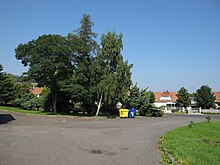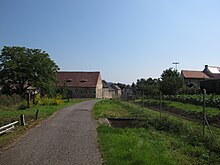Odolice
| Odolice | ||||
|---|---|---|---|---|
|
||||
| Basic data | ||||
| State : |
|
|||
| Region : | Ústecký kraj | |||
| District : | Must | |||
| Municipality : | Bělušice | |||
| Area : | 449.1638 ha | |||
| Geographic location : | 50 ° 27 ' N , 13 ° 46' E | |||
| Height: | 301 m nm | |||
| Residents : | 63 (March 1, 2001) | |||
| Postal code : | 434 01 | |||
| License plate : | U | |||
| traffic | ||||
| Street: | Most - Louny | |||
| Railway connection: | Čížkovice – Obrnice | |||
Odolice , until 1923 Vodolice (German Wodolitz ) is a district of the municipality Bělušice in the Czech Republic. It is located 13 kilometers southeast of Most and belongs to the Okres Most .
geography
Odolice is located in the south-west of the Central Bohemian Uplands in the area of the protected landscape area CHKO České středohoří . The village is located at the foot of the Odolický vrch and Skála hills above the source of the Odolický creek.
The Jílový (346 m) and the Tobiášův vrch (354 m) rise to the north, the Číčov (477 m) and the Dlouhá (483 m) to the northeast, the Mlýnský vrch (336 m) and the Větrník (297 m) to the east, in the southeast of the Malý vrch (375 m), the Křížové vršky (386 m), the Brník (471 m), the Srdov (482 m) and the Oblík (509 m), south of the Raná (457 m) and the Odolický vrch (379 m), in the southwest of the Milá (510 m), west of the Bečovský vrch (363 m) and the Skála (386 m) and in the northwest of the Bělouš (399 m). On the eastern edge of the village, the road I / 28 runs between Most and Louny , and to the north is the Čížkovice – Obrnice railway line .
Neighboring towns are Dobrčice, Chrámce and Kozly in the north, Jablonec and Hořenec in the northeast, Sinutec in the east, Charvatce, Mnichov and Oblík in the southeast, Raná and Hrádek in the south, Břvany , Milá and Počerady in the southwest, Volevčice and Bečov in the west as well as Bělušice Skršín in the northwest.
history
The first written mention of the village and farm Odolice was in 1203 as the property of the Osek monastery . The estate later came to secular owners, and a fortress was first mentioned in 1504. In 1601, Stephan Georg von Sternberg acquired the estate and added it to his rule Postelberg . After his death in 1625 an inheritance was divided, whereby his eldest son Adam († 1633) received the goods Vodolice and Pátek. Adam's son Johann Stephan von Sternberg exchanged Vodolice for the Mirošovice estate with his uncle Johann Rudolf von Sternberg on Postelberg after his father's death.
This exchanged the rule Postelberg including the estate Wodolitz in 1637 with Wenzel Michna von Vacínov for the rule Zásmuky . Later, the lords of Lobkowicz acquired the Wodolitz estate and combined it with their Liebshausen lordship . The desert fortress was last mentioned in 1664, later it was razed.
In 1831 the village of Wodolitz , located on the left-hand side of Biliner Chaussee in the south-westernmost tip of the Leitmeritz district , consisted of 19 houses with 86 German-speaking residents who lived from agriculture. In the village there was an official farm, a sheep farm and a carp pond. The parish was Kosel . Until the middle of the 19th century, Wodolitz remained subject to the allodial rule Liebshausen.
After the abolition of patrimonial formed Wodolitz / Vodolice 1850 a district of the municipality Kosel / Kozly in Leitmeritzer county and judicial district Bilin . At that time, 82 people lived in the village. From 1868 the village belonged to the Teplitz district and from 1896 to the Dux district . In 1869 Wodolitz had 153 inhabitants. Between 1897 and 1898, the Brüx-Lobositzer connecting railway was used to build the Tschischkowitz-Obernitz local railway, popularly known as the Powidlbahn . Wodolitz received a train station at its apex. In 1900 the village had 223 inhabitants. At the beginning of the 20th century a two-class Czech village school was established. In the 1920s, the greater Kosel community disintegrated; Wodolitz / Odolice became an independent municipality. In 1927 one third of the 231 inhabitants were German Bohemia. In 1930 Wodolitz had the highest population in its history with 239 people. As a result of the Munich Agreement , Wodolitz was added to the German Reich in 1938 and initially belonged to the Dux district . From May 1, 1939, the village was part of the newly formed district of Bilin . In the census of May 17, 1939, the community had only 150 inhabitants due to the emigration of a large number of Czechs. After the end of the Second World War Odolice came back to Czechoslovakia and the German-Bohemian population was expelled . In 1950 the number of inhabitants had fallen to 101 people.
In the course of the abolition of the Okres Bílina, Odolice was incorporated into Bělušice in 1961 and assigned to the Okres Most. At that time 115 people lived in Odolice, nine years later there were only 91. The chapel in the village square was demolished in the second half of the 20th century and a green area was created in its place. The train station was also canceled. In 1991 the village had 65 inhabitants, at the 2001 census 63 people lived in the 27 houses in Odolice.
Community structure
The district Odolice also forms a cadastral district.
Web links
Individual evidence
- ↑ http://www.uir.cz/katastralni-uzemi/602051/Odolice
- ↑ http://www.soupispamatek.cz/arl-kcz/cs/detail-kcz_un_auth-0003610-Tvrz-Odolice/
- ^ Johann Gottfried Sommer The Kingdom of Bohemia, Vol. 1 Leitmeritzer Kreis, 1833, p. 71
- ↑ http://www.soupispamatek.com/okres_duchcov/foto/odolice/odolice.htm
- ^ Michael Rademacher: German administrative history from the unification of the empire in 1871 to the reunification in 1990. Bilin district. (Online material for the dissertation, Osnabrück 2006).
- ↑ http://www.czso.cz/csu/2009edicniplan.nsf/t/010028D080/$File/13810901.pdf




